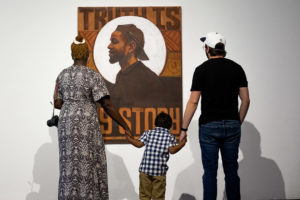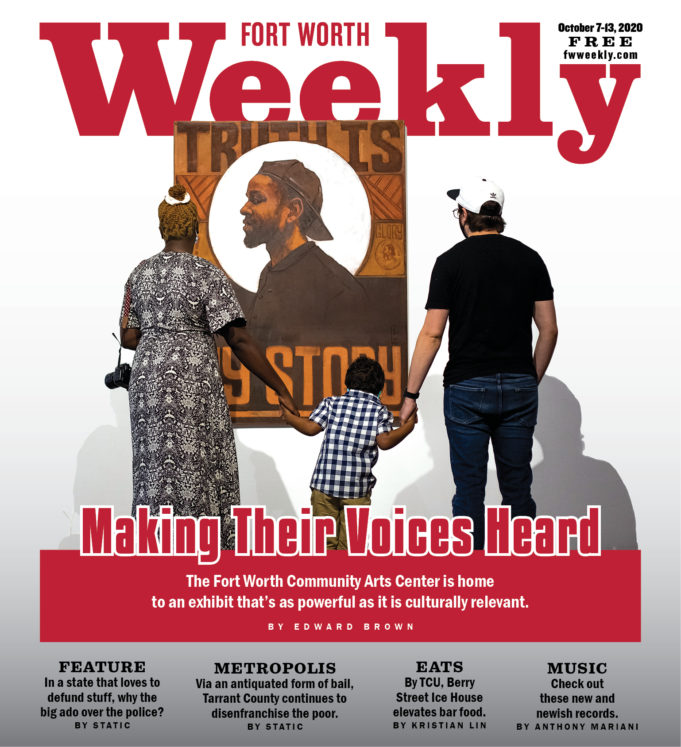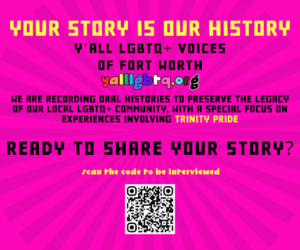The Black Lives Matter movement has made diversity and social justice an imperative for local fine arts groups that purport to support racial equality and social justice. Economic justice — the notion that societies are just when pay is fair — may be harder to come by, though. While a young person may be content earning subsistence hourly wages at a local museum, the top earner at that same institution can garner $600,000 a year. Those disparities are becoming harder (if not impossible) to justify.

Photo by Shauna Benoit
As discussions about social justice become the norm in private and public conversations, artists are making their voices heard, and Fort Worth now flowers with murals depicting victims of systems of oppression. A mural of Atatiana Jefferson watches over a corner of Evans Avenue on the East Side, and, although she wasn’t local, Vanessa Guillen’s visage has become a feature of Fort Worth’s landscape, thanks to two recent murals by Juan Velazquez.
Our Faces, Our Voices, showing at the Fort Worth Community Arts Center through Saturday, Nov. 7, is the most recent addition to a line of artist responses to police shootings and a president whose tweets and public statements too-frequently give comfort to white supremacists. The self-portraits by 15 minority artists tell 15 stories through honest and visually captivating means.
The show connects artists with viewers through printed quotes.
“I chose to be an artist because I didn’t see artwork that looked like me,” Stacie Monday writes as a preface for “The Mark of Monday,” a bold painting.
Nearby, a confident Black female face with her eyes turned toward the viewer held my attention for several minutes. The detailed facial features and frock of outlined hair redirected my gaze back to her eyes. A small cutout near her mouth that reads, “Post Card” pointed toward an inner narrative without revealing much more.
LatinX artists are well-represented. Armando Sebastian describes his love of Mexican folk art and the lively colors associated with that tradition. Nature plays prominently in his self-portrait (“Mestizo, I Know Who I Am”) as brightly colored birds perch on flowering branches just inches from his stoically poised body. Floating petals and the placement of his upper torso and relaxed gaze portray a young man who is at home with himself and his dual connections to Mexico and the United States.
Lauded North Texas artist Riley Holloway was a natural fit for the show, given his reputation for masterful portraits of Black men and women. “Truth Is” features Holloway glancing toward the left side of the canvas, like an inverted penny. (Abraham Lincoln’s visage stares straight onto the right side of the one-cent piece.) Other allusions to that humblest of coins include a bronze color scheme, the word “Glory” (which hinted to “Battle Hymn of the Republic”), and a miniature coin resting behind Holloway’s head.
Jerry Lynn’s “His Story” superimposes Black Lives Matter marchers over a highly detailed rendering of his head, which gazes unemotionally toward the right of the canvas. A stream of sunlight bathes the protesters in golden hues. Forming the base of the work are less descript Black men and women whose thick black outlines lend a graphic novel feel to the lower third of the painting. Lynn shows a knack for creating artistic layers that are distinct yet complementary, blending heavy thematic imagery with forceful colors and varied textural elements.
Each self-portrait is as unique as the personality that crafted it. The widely spaced paintings allow for ample social distancing. Through its promotional material, the exhibit makes no secret of its aim: to reverse underrepresentation of minority artists on gallery and museum walls.
Many of Fort Worth’s artists and directors at local galleries and museums are well-aware of the stark whiteness of top leadership at our artistic institutions. It doesn’t take a culture vulture to notice that the Amon Carter Museum of American Art, Modern Art Museum of Fort Worth, and Fort Worth Community Arts Center have all taken steps to improve diversity among the artists and subjects that are shown and promoted.
The Carter Community Artists outreach program, for example, has done a commendable job of selecting brilliant artists who reflect the diversity of the communities served by the museum ambassadors. We can only hope that those same cultural institutions are beginning to have discussions on how to break systems that have historically allowed only white men and, to a lesser degree, white women to reach six-figure salaries and higher. Our Faces, Our Voices has shown that powerful artistic narratives can reach wide audiences when the artists work in solidarity toward a just and beautifully presented cause.
Our Faces, Our Voices












